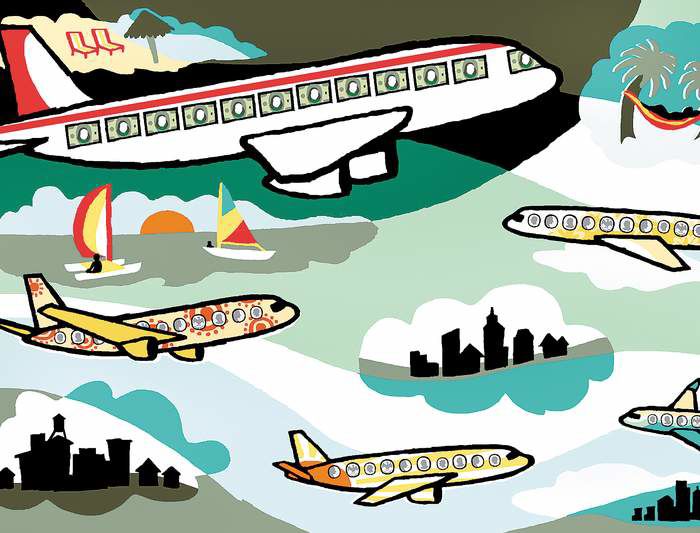Budget airlines attract fliers with new routes, low fares
Published 5:00 am Tuesday, May 3, 2011

- As major carriers continue to raise rates and cut capacity, budget airlines with names such as Vision, Sun Country and Direct Air, which operate mainly out of small American cities, are adding flights with low fares.
Eva Pickens has made the six-hour drive between Huntsville, Ala., where her son lives, and her hometown near Destin, Fla., too many times to count. So when she saw that a carrier called Vision Airlines was advertising $49 one-way nonstop flights between the two places, she snapped up a ticket. By comparison, “filling up my gas tank now costs like $62,” said Pickens, a community association manager for a beachfront condo.
As major carriers continue to raise rates and cut capacity, budget airlines with names such as Vision, Sun Country and Direct Air, which operate mainly out of small U.S. cities, are adding flights with low fares.
Vision Airlines, based in Suwanee, Ga., started out as a charter service in 1994 and began flying scheduled service late last year between Atlanta and Louisville, Ky., and between Niagara Falls, N.Y., and northwestern Florida. It now flies prop planes and Boeing 737 jets from its hub in Destin to more than 20 cities in the Southeast with rates typically $89 to $109 each way.
Direct Air, based in Myrtle Beach, S.C., provides nonstop service to more than 15 cities, including Newark, N.J., Pittsburgh and Columbus, Ohio, by chartering planes from other airlines. Later this year, it is adding flights to San Juan, Puerto Rico; the Bahamas; and Lakeland Linder Regional Airport in Florida, with rates as low as $79 each way when on sale.
And Sun Country Airlines, which flies 737s from Minneapolis/St. Paul, where it is based, to more than 30 destinations throughout the United States, Mexico and the Caribbean, will begin flying to London Gatwick on May 27 with rates from $422 one way in the summer.
Under the radar
Never heard of these airlines? That may be because of their low-profile business style, which typically focuses on linking small cities to vacation destinations, largely avoiding direct competition with bigger airlines, and relying more on word of mouth than costly marketing blitzes. Some, including Direct Air and Allegiant Air (which flies from Redmond to Las Vegas and Arizona), even refuse to pay to list fares at online agencies like Expedia or Travelocity, which means that travelers have to visit the carriers’ own websites to find their flights.
All of this helps keep costs down and fares low.
“We don’t have a massive overhead like we would if we were a legacy carrier,” said David Meers, chief operating officer at Vision Airlines.
In addition, the budget carriers’ low-fare strategies involve selling not just airline seats, but also hotel rooms and car rentals. With packages, Meers explained, “there’s a little bit of a margin for the airline as well, which helps to defray increases in fuel prices.”
One of the tradeoffs of flying a budget carrier used to be having to pay fees for things like checked bags and snacks, but now that most major airlines charge for the same things, such fees are almost expected. Allegiant, for example, charges for drinks and snacks, checked bags and seat assignments. Vision, on the other hand, offers free drinks, snacks and seating assignments. Another issue to be aware of is the age of the planes. Some of the budget carrier planes are on the older side. Allegiant, for example, flies MD-88s, which are, on average, 21.5 years old. Vision’s fleet, as well as aircraft chartered by Direct Air, include some older-model Boeing 737s (which were not subject to airworthiness inspections in the wake of the depressurization incident on a Southwest Airlines Boeing 737-300 series aircraft on April 1). Each carrier is subject to the same safety and maintenance regulations as its larger competitors.
“Safety is our first priority, and our aircraft are maintained in accordance with all FAA regulations,” said Jordan McGee, an Allegiant spokeswoman, who also noted, referring to its MD-88 fleet, “because of our low frequency of flights, we only put about 1,000 cycles per year on them.”
Passengers should be prepared for fewer routes and less frequent flights. While most flights are nonstop, few are offered on a daily basis. Small fleets and limited service mean a lack of backup options when flights are delayed. “When you get in trouble,” said Rick Seaney, chief executive of Farecompare.com, “you may not get home for a while.”
Budget carriers say they can’t afford to disappoint customers by canceling flights. Edward Warneck, president of Direct Air, said his carrier would land in a different airport if necessary (Boston instead of Worcester, Mass., for example) and shuttle passengers to their original destinations by bus.
“Given the choice,” he said, most passengers “would rather be late than not get there at all.”






